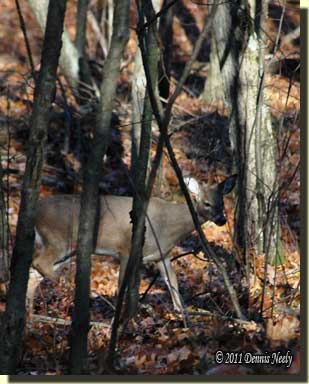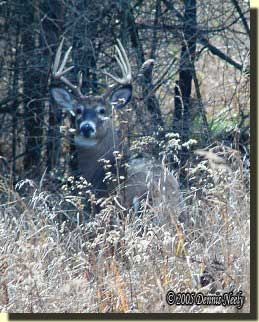A hint of brown moved behind a red cedar tree. Brittle leaves clattered overhead. Arteries throbbed. A cool breeze carried the aroma of rotting duff as doubt festered. A dark foreleg stepped, then paused. Heartbeats stacked up like wood corded for a long winter. Another leg flexed, black with wet mucky socks that stretched above the knee. The deer dropped its head; petite, creamy tines followed.
The young buck sniffed the earthen trail. His nose twitched, swinging side to side, sorting scents. After the next hoof-fall, the cautious whitetail raised his head a bit and looked about. His pink tongue licked his snout. The deer melted into a tangle of leafy autumn olive bushes, then continued his still-hunt, not 30 paces distant. I counted six points with no brow tines.
Beyond the buck, three squeaky clucks told of a wild turkey wandering downhill in search of an evening roost. Intrigue grew; a bigger, broader, fuller-bodied, elusive buck sometimes trailed this little one. As it so often does, my right thumb fiddled with the flintlock’s jaw screw as I watched where the small stag came from, not where it was going.
A dozen steps downhill from the main doe trail the six-pointer turned about quick, then gazed to the north. The bigger buck preferred to skulk about with the wind at his rump. On that evening in 1792, an approach from the north seemed probable, I reasoned. I eased my left leg up, rested my elbow on that knee and settled the Northwest gun against my shoulder.
 The turtle sight stalked the young stag back uphill. It stopped and sniffed again at the doe trail, sneaking a handful of quick glances in the direction where I hoped the big buck stood. After a few minutes, a yearling doe scampered past the six-pointer on the downhill side. To my surprised, the buck paid no attention to her. A second deer followed, and again the little stag ignored her.
The turtle sight stalked the young stag back uphill. It stopped and sniffed again at the doe trail, sneaking a handful of quick glances in the direction where I hoped the big buck stood. After a few minutes, a yearling doe scampered past the six-pointer on the downhill side. To my surprised, the buck paid no attention to her. A second deer followed, and again the little stag ignored her.
Far off to the east a large flock of geese took wing, or so it sounded. The air filled with goose music; the does’ footfalls jostled leaves about, but I never heard them over the thunderous ke-honking. As the geese crossed the River Raisin the young buck flicked his tail twice, then walked off to the north. I waited until dark, but the sagacious buck never arrived.
“Why are you dressed like an Elf?”
The navy-blue plastic chair squeaked when I shifted my weight. A gray-haired lady of slight build took a seat in the library’s auditorium, intentionally leaving an empty chair between us. We exchanged nods, and I said, “Good evening.” She gave me a strange look as she removed her calf-length, beige wool coat, then responded with a hesitant smile.
The moderator for the Carnegie Library’s reading night adjusted the podium and tapped the microphone. As folks filed in, curiosity got the best of the lady. She turned to me and asked, “Why are you dressed like an elf? Are you reading a children’s book tonight?”
“No,” I said, trying to stifle a laugh, “I’m a living historian. These are the clothes of an 18th-century woodsman. I write about the Old Northwest Territory, the River Raisin and hunting in the 1790s. I’m a time traveler of sorts, and I’ll be reading the beginning of a true adventure set in 1794.”
The lady raised her eyebrows when I mentioned “time traveler of sorts,” but I overlooked her reaction and went about describing what I was wearing and how each garment was documented through the writings of a favorite hunter hero, museum artifacts or paintings and illustrations from my chosen time period.
That’s not the first time that my mention of time travel has drawn such a response; I’m sure it won’t be the last. I have even been rebuked by other traditional hunters for being a “bit over the top” with such comments.
I read just before the intermission, and I never made it to the refreshment table. My new-found friend and two other guests had never met a living historian, much less a traditional woodsman, and the questions gushed forth. After explaining some of the passage that I read in the context of 18th-century life, the conversation turned to the basics of this glorious hobby.
“Sagacity” and Time Travel
During the second intermission the lady zeroed in on time traveling, what I meant and how it worked. I spoke of the buck that I chased for three seasons and used the words “superior sagacity” when describing that stag. I told of how at the strangest times in the pursuit I felt like I was living a portion of a passage in the journal of a long-dead author, and how a living historian’s version of time travel involves creating a bond with someone who lived long ago.
A look of quiet contemplation overtook the lady when I said “superior sagacity.” After a pause, she shared how her father used that word and how “you took me back to when I was a child and I remembered my father and our old house.” I didn’t miss the opportunity to tell her, “You just time traveled.”
 I explained that I couldn’t quote the entire passage from Joseph Doddridge verbatim, but that the reverend’s use of “superior sagacity” when describing a wily buck came to mind more than once during that fall’s hunts. For me, superior sagacity acts like a mental trigger, a sudden poof of the sorcerer’s smoke that sends the historical me hurtling back through time’s portal. Even the sound of the words as they trip from the tongue possesses a magical effect.
I explained that I couldn’t quote the entire passage from Joseph Doddridge verbatim, but that the reverend’s use of “superior sagacity” when describing a wily buck came to mind more than once during that fall’s hunts. For me, superior sagacity acts like a mental trigger, a sudden poof of the sorcerer’s smoke that sends the historical me hurtling back through time’s portal. Even the sound of the words as they trip from the tongue possesses a magical effect.
“Often some old buck, by the means of his superior sagacity and watchfulness, saved his little gang from the hunter’s skill by giving timely notice of his approach. The cunning of the hunter and that of the old buck were staked against each other, and it frequently happened that at the conclusion of the hunting season the old fellow was left free, [an] uninjured tenant of his forest…” (Doddridge, 101)
In the short time that we had, I touched on the writings of Professor Jay Anderson and how he spoke of experiencing the “texture” of life in the past, which meant for me to learn what it felt like to live in the 1790s and what it felt like to hunt in that era.
I went on to say that Anderson used the analogy of present-day folks drifting in a boat on a winding river, of how the past was hidden from us just around the bend. He pointed out that the trick was to figure out how to beach the boat and walk around the river’s bend, to experience a breakthrough within one’s mind that frees us from the present so we can explore the past.
“Can you smell the room where your father was? Feel the carpet or the weave of his coat? Do you remember what his voice sounded like?” I asked. “That is the texture of the past that we seek.”
“I remember his cologne, and the carpet was wool and very scratchy. It happened so fast, the memory only lasted for a second or so,” she said, clearly trying to bring back that moment.
“Welcome to time traveling,” I said as the moderator called us back to our seats. I had just enough time to tell her that living historians chase after these pristine moments, points in time when the past seems real, if only for a few heartbeats.
Give traditional black powder hunting a try, be safe and may God bless you.


